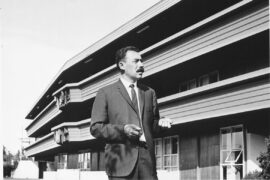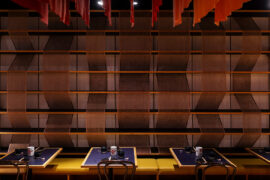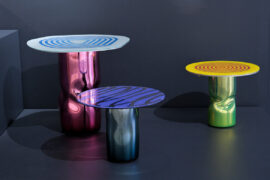If our national seat of power isn’t safe from extreme weather, what in Australia is?

January 22nd, 2020
If you’ve ever visited Parliament House you probably noticed several things, like the glorious upward sweep of the architecture and how that absolutely does not go with the temporary fencing to keep people off the lawns or the armoured police with semi-automatic weapons standing around out the front.
That’s largely because the original idea with the building’s inspired design by Romaldo Giurgola was that it would be a welcoming place by and for The People (hence the sweeping lawns leading over the top of the chambers, in order that the public might literally walk over the politicians) whereas the current vibe is much more about keeping the filthy non-lobbying classes the hell away from the dignified business of parliament.
Sadly, however, there is one intruder from which even the most theatrically over-armed guard cannot defend our federal seat of government against: sky ice.

Sky ice.
The nation’s capital was recently battered by hail the size of golfballs – which is the typical base unit of hail – which also wrought havoc on the CSIRO’s greenhouses and destroyed years of research in what we assume is a definitive result from God regarding that whole science-vs-religion thing.
And if you just had an unseasonal shiver down your spine at the idea that the east coast had a massive hailstorm in January during the worst summer bushfires in living memory, then don’t worry: that’s perfectly normal, and soon horrific weather extremes will be so commonplace as to be downright boring for everyone not actually killed by them.
It does, however, raise the question of what we can do to protect Parliament House from all that climate change outside, even as it’s largely denied within the building itself.

Parliament House when it’s not covered in a ton of ice
And there is a lot of work going on in designing buildings better equipped to deal with climate change – specifically, the already far too predictable effects like warmer temperatures and sea level rise, better energy efficiency and grey water usage to lower the environmental footprint, but now that Mother Nature is auditioning new ways to kill us it’s worth asking what dear god what we can do to appease her.
Parliament House has a few nifty green elements – there’s a rooftop slab array, for one thing, which runs enough energy to light the place – but probably the single biggest advantage of the House design in an era of extreme weather is that the mighty flagpole which stands proudly atop the roof would probably make a great lightning rod and therefore open the way for cartoonish mad science, as befits a parliament with One Nation senator Malcolm Roberts in it. After all, it’s the only science of which he seems to approve.
Parliament House sits atop a hill which gives it some immediate flood protection, and its semi-buried nature gives some natural insulation and helps stop it being a heat island in the way that so many metropolitan developments become. The flip side of that is that it’s not exactly got great natural airflow since all that earth gets in the way – but that also means it’s not filled with the rich woody aroma of the east coast burning to a cinder.

Can’t do much about the ominous orange glow though
And that’s one of the biggest problems facing architecture generally, for our federal seat of power and beyond. While many countries are looking to smart design for solutions, Australia is facing a future of weather events with contradictory needs: airflow for better cooling in our hotter seasons versus systems we can look down in high air pollution days, or squat, heavy-eaved houses for better fire protection versus elevated buildings to minimise flood damage.
We’re evidently going to get everything from fire to murder-hail in our new X-Treem Seazons (tagline: “This Ain’t Your Grandaddy’s Annual Climate Variation!”) and mitigating one risks making us vulnerable to the others. You’d call it a perfect storm, were that not just another form of extreme weather for which we’re woefully underprepared.
So this feels like a perfect opportunity for some brilliant design-minds to start coming up with the Houses Of The Future – I’m thinking something fireproof, low-impact, and buoyant that’s also hail-resistant and immune to the rains of frogs, blood and locusts which are presumably coming in February.

Pictured: Melbourne next week
And maybe large enough to contain our houses of parliament, since it looks like they might be in the market sooner rather than later.
If you loved this, we think you’d might like Where there’s smoke, there’s more smoke. Join our digital community and get weekly inspiration straight to your inbox.
INDESIGN is on instagram
Follow @indesignlive
A searchable and comprehensive guide for specifying leading products and their suppliers
Keep up to date with the latest and greatest from our industry BFF's!

A curated exhibition in Frederiksstaden captures the spirit of Australian design
The new range features slabs with warm, earthy palettes that lend a sense of organic luxury to every space.

The undeniable thread connecting Herman Miller and Knoll’s design legacies across the decades now finds its profound physical embodiment at MillerKnoll’s new Design Yard Archives.

London-based design duo Raw Edges have joined forces with Established & Sons and Tongue & Groove to introduce Wall to Wall – a hand-stained, “living collection” that transforms parquet flooring into a canvas of colour, pattern, and possibility.

A retrospective at Canberra Museum + Gallery honours Enrico Taglietti, shaping the exhibition through his own design principles.

Designed by Kelly Ross, the newest addition to Bisa Hospitality’s portfolio represents more than just another restaurant opening.

Despite its long and rich history, signwriting is a profession in decline. Will Lynes’ new show, Oily Water at Canberra Glassworks, aims to showcase the techniques of the trade to highlight its potential in design.

The Australian Passivhaus Association (APA) has released a guide outlining the process for achieving the international Passivhaus Standard, providing clarity on appropriate use of the term and the legal risks of incorrect assertions.
The internet never sleeps! Here's the stuff you might have missed

On 6th September, Saturday Indesign lit up Melbourne with a day of immersive installations, design talks and showroom activations across three thrilling precincts.

Richmond came alive for Saturday Indesign 2025 as showrooms, rooftops and laneways transformed into a celebration of design, creativity and connection.